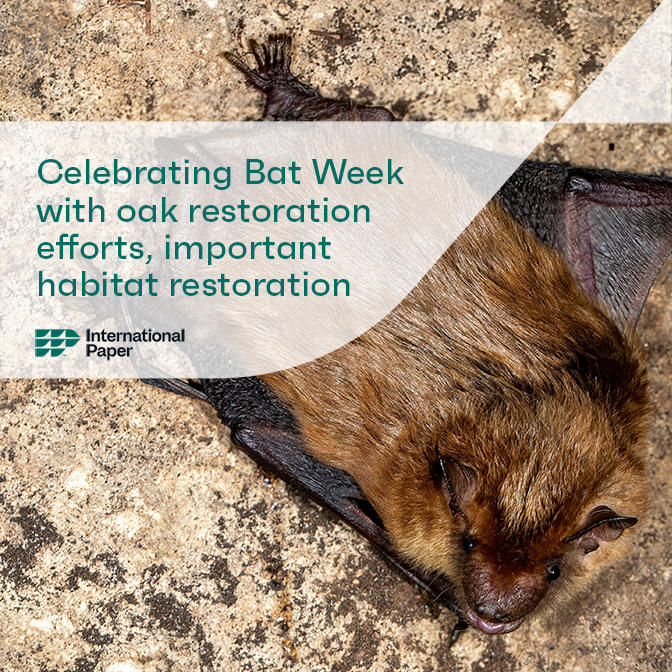How Forest Restoration Supports Bat Conservation
Bats play a vital role in our ecosystems, from pollinating plants to controlling insect populations. In honor of #BatWeek, we are proud to highlight our partnership with the National Fish and Wildlife Foundation (NFWF) to restore critical bat habitats through oak regeneration projects in Alabama.
As part of the Forestland Stewards Partnership, a long-standing collaboration between IP and NFWF, grants are provided to support the restoration of forest ecosystems, benefiting wildlife like bats that depend on mature oak trees for roosting.
Bats play a critical role in the ecosystem by pollinating plants, and controlling insect populations, especially mosquitoes. However, the bat population has been severely impacted by white-nose syndrome (WNS), a disease that has killed millions of bats over the past decade. Since its discovery in New York in 2006, WNS has spread to 40 states and nine Canadian provinces, with up to 100 percent of bats disappearing in some affected areas.
WNS is caused by a cold-loving fungus that attacks hibernating bats. More than half of the bat species in the U.S. and Canada hibernate during the winter, making them vulnerable to the disease. Without effective solutions, several species are at risk of extinction.

Through the Forestland Stewards Partnership, IP and NFWF are working to restore important habitats, particularly white oak forests, which provide essential shelter and roosting spaces for bat populations. The Alabama Forestry Foundation (AFF), a grant recipient, has spearheaded white oak restoration efforts using sustainable forestry techniques such as midstory removal, which encourages young oak growth and improves the habitat quality for bats and other wildlife.
“This collaboration ensures the future of key species and forests while creating opportunities for landowners to take an active role in conservation. This restoration effort exemplifies the power of collective action for sustainability,” said Sophie Beckham, Vice President and Chief Sustainability Officer at International Paper.
To help private landowners learn these practices, AFF hosts volunteer events to establish and maintain white oak forests, collaborating with foresters and biologists in landowner hands-on experiences that will help bolster bat populations across the region. One volunteer, Lamar Dewberry and his wife Felicia, landowners from Clay County, have attended multiple events and have even been inspired to be more involved. The Dewberrys offered their land, reserving seven of their 70 acres for other landowners to learn and practice white oak regeneration for the wildlife on their lands.
Our efforts focus on rebuilding white oak forests—key roosting spaces for bats—ensuring these important species can thrive despite the challenges they face. Through sustainable forestry practices, we’re working to secure a future for bats and other wildlife that depend on these ecosystems.
“Being part of this project showed us the direct impact we can have on our land. It’s inspired us to offer more hands-on opportunities for fellow landowners, giving them the tools to improve forest management and habitat restoration.”
He continued, “Seeing firsthand how these practices help restore crucial species like bats has been eye-opening. The collaboration between landowners and conservation experts is key to making a real difference in our environment.”
The Forestland Stewards Partnership has supported critical forest restoration projects that enhance habitats, foster biodiversity, and engage local communities. These collaborative efforts are expected to improve the health of Alabama’s oak forests and benefit species like bats that are essential to the region’s ecosystems.
Learn more about the Longleaf Landscape Stewardship here: www.nfwf.org/programs/longleaf-landscape-stewardship-fund.
About the National Fish and Wildlife Foundation
Chartered by Congress in 1984, the National Fish and Wildlife Foundation (NFWF) protects and restores the nation’s fish, wildlife, plants and habitats. Working with federal, corporate, foundation and individual partners, NFWF has funded more than 6,800 organizations and generated a total conservation impact of more than $10 billion. NFWF is an equal opportunity provider. Learn more at nfwf.org.



